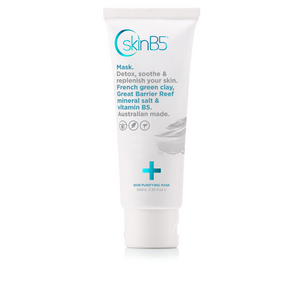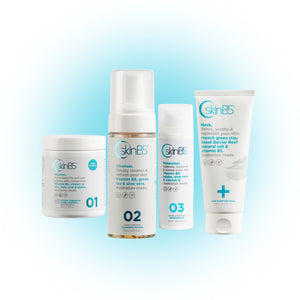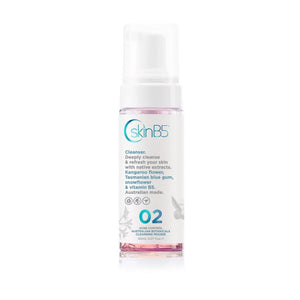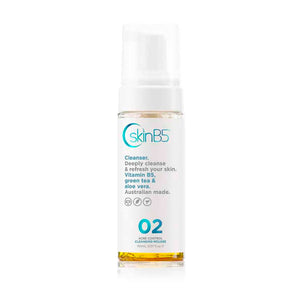How to Treat Clogged Pores
Posted by Jammy Justimbaste on
Clogged pores are a common skin concern that can lead to breakouts, blackheads, and an uneven complexion. They occur when oil, dead skin cells, and debris accumulate in the pores, preventing them from functioning properly. Addressing clogged pores is essential for maintaining clear, healthy skin and preventing acne.
Go straight to treatments (Jump Link)
What Are Clogged Pores?
Clogged pores are tiny openings in the skin that become blocked with a combination of sebum (natural oil), dead skin cells, and external impurities. These blockages can lead to various skin issues, including blackheads, whiteheads, and acne.
Common Areas Affected by Clogged Pores:
- Face (nose, chin, forehead, cheeks)
- Armpits
- Breasts
- Back and shoulders
What Do Clogged Pores Look Like?
Identifying clogged pores can help differentiate them from other skin conditions. Some common signs include:
- Blackheads – Dark, oxidised oil trapped in the pores
- Whiteheads – Small, white or flesh-colored bumps
- Rough or bumpy skin texture
- Enlarged pores that appear visibly congested and common with oilier skin types
What Causes Clogged Pores?
Understanding the causes of clogged pores can help prevent them from forming. Some key factors include:
- Excess oil production – Overactive sebaceous glands can cause pores to become congested.
- Dead skin cell buildup – Without proper exfoliation, dead skin cells can block pores.
- Makeup and sweat – Cosmetics, sunscreens, dirt, and sweat can clog pores, especially if not removed properly.
- Use of comedogenic products – Certain skincare, suncare and makeup products can contribute to pore congestion.
- Hormonal changes and stress – Fluctuations in hormones can increase oil production, leading to clogged pores.
Treatments
General Treatment Methods
A consistent skincare routine is key to preventing and treating clogged pores. Using non-comedogenic products, cleansing regularly, and exfoliating can make a significant difference.
At-Home Treatment Options
1. Cleansing and Exfoliation
- Use gentle, exfoliating cleansers containing salicylic acid or glycolic acid to remove dead skin cells and prevent buildup.
- SkinB5’s Acne Control Cleanser helps clear pores and maintain a balanced complexion.
2. Steam Treatments
- Steam opens up the pores, loosening debris and making it easier to remove.
- How to do it: Boil water, pour it into a bowl, and place your face over the steam with a towel draped over your head for 5-10 minutes.
3. Clay Masks and Pore Strips
- Clay masks especially those contains kaolin help draw out impurities, while pore strips can remove surface-level debris from the nose and chin.
- Be cautious with overuse, as these methods can compromise the skin barrier and cause skin irritation.
4. Retinol Serums
- Retinol helps accelerate cell turnover, reducing clogged pores and breakouts.
- Introduce it gradually to avoid irritation.
Spot Treatments for Specific Areas
Nose and Chin
- Blackheads and whiteheads commonly occur here due to excess oil production.
- Consider targeted treatments like SkinB5’s Acne Control Moisturiser, which hydrates without clogging pores.
Forehead
- The T-zone tends to be oilier, so balancing hydration and oil control is essential.
- Avoid heavy hair products that may contribute to forehead breakouts.
Armpits
- Clogged pores in the armpits can be caused by antiperspirants, sweat, and hair removal.
- Exfoliate gently and switch to natural deodorants to prevent buildup.
Breasts
- Sweat, friction, and hormonal fluctuations can lead to clogged pores on the chest area.
- Wash regularly with a gentle cleanser and avoid tight clothing.
Professional Treatments for Clogged Pores
If at-home treatments don’t work, professional procedures can help:
1. Extractions
- Performed by a dermatologist or aesthetician, extractions remove deeply clogged pores safely.
2. Chemical Peels
- Light, medium, or deep peels help resurface the skin and prevent future pore congestion.
3. Microdermabrasion and Facials
- Professional exfoliation treatments help remove dead skin cells and unclog pores effectively.
How to Prevent Clogged Pores
- Follow a daily skincare routine with non-comedogenic products.
- Remove makeup before bed to prevent buildup.
- Exfoliate 2-3 times a week to keep pores clear.
- Stay hydrated and eat a balanced diet to support skin health.
- High dose Vitamin B5 supplement is known to help metabolise and regulate skin oil production and prevent and reduce skin congestion.
When to See a Dermatologist
If clogged pores persist despite regular treatment, it may be time to seek professional help. A dermatologist can provide:
- Prescription-strength treatments like retinoids
- In-office procedures for deep pore cleansing
- Guidance on managing persistent acne
Frequently Asked Questions
What’s the difference between clogged pores and acne?
Clogged pores can lead to acne, but not all clogged pores result in breakouts. Acne is often accompanied by inflammation and pus-filled lesions.
Are clogged pores the same as blackheads and whiteheads?
Blackheads and whiteheads are forms of clogged pores. Blackheads are open clogged pores, while whiteheads are closed pores.
Can clogged pores go away on their own?
Some mild cases may clear up naturally, but regular skincare helps prevent recurrence.
How long does it take to treat clogged pores?
It depends on the severity, but with consistent care, improvement can be seen in a few weeks.
Can clogged pores cause permanent skin damage?
If left untreated, clogged pores can lead to breakouts or enlarged pores. Proper care helps maintain healthy skin.
By following the right treatments and preventive measures, you can keep your pores clear and your skin looking its best. SkinB5’s range of blemish-fighting products can support your skincare journey with scientifically backed formulas that help maintain clear and healthy skin.




